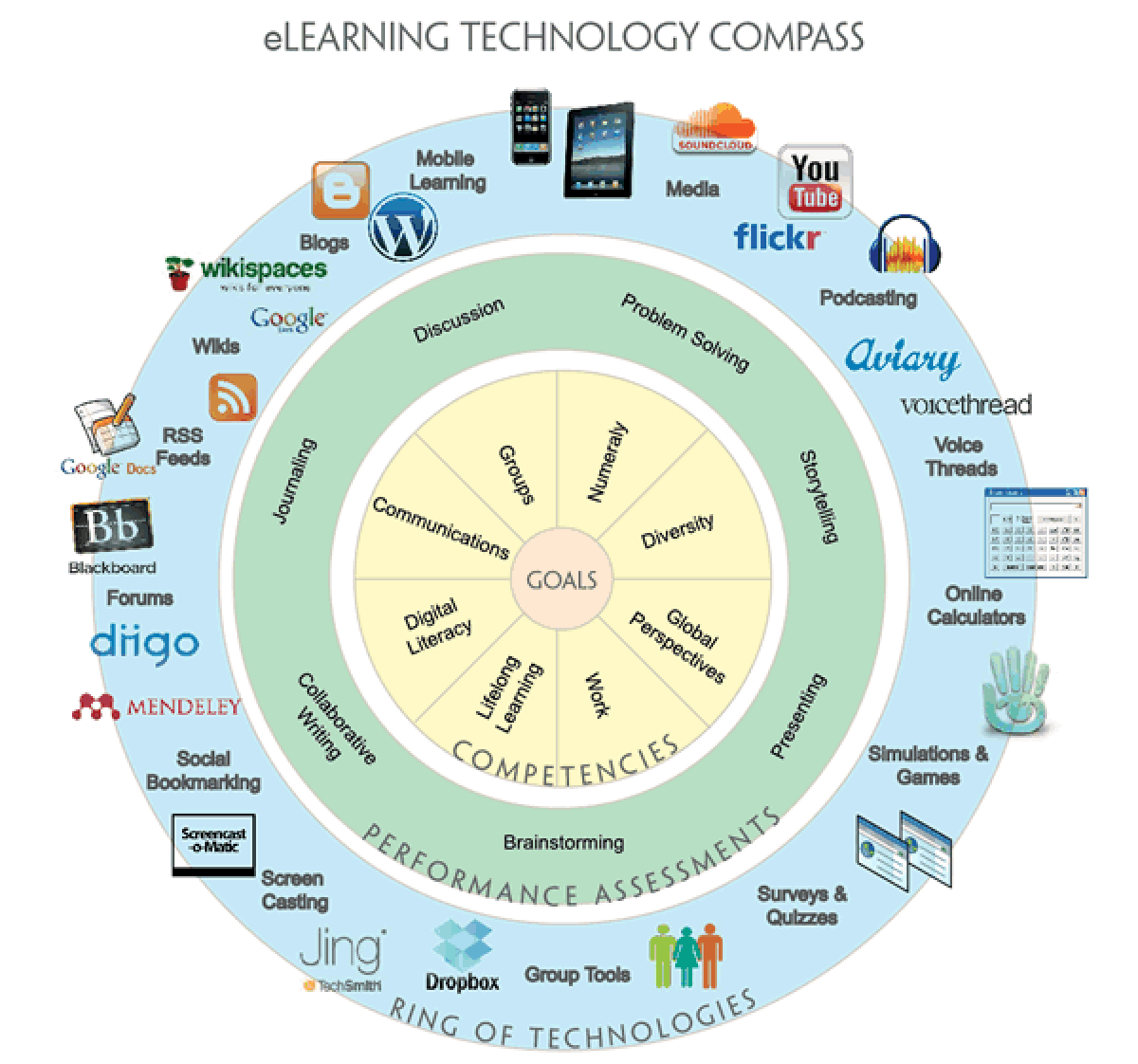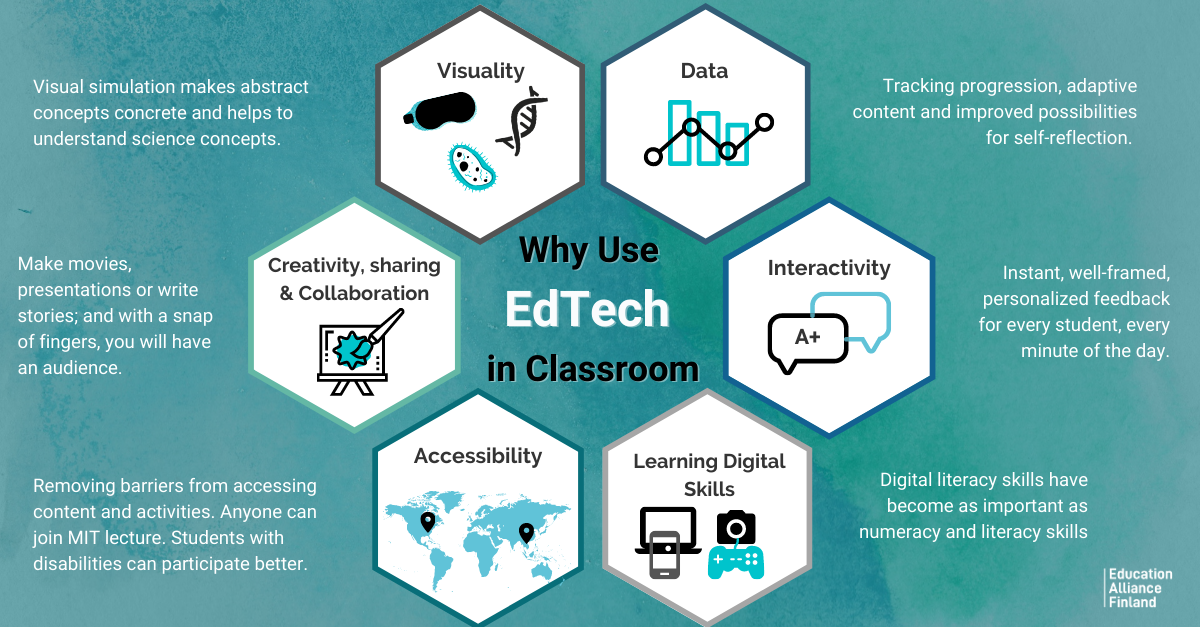In today's rapidly evolving educational landscape, technology has become an integral part of the learning process. From classrooms to online platforms, educational technology, often referred to as edtech, has transformed the way students access information, engage with content, and interact with instructors. In this blog post, we will explore the world of educational technology, examples that demonstrate its breadth, and its profound impact on academia.
What is educational technology?
Educational technology refers to the use of digital tools—hardware and software—and resources to facilitate teaching and learning processes. It encompasses a wide range of applications such as online learning platforms, interactive educational software, virtual reality simulations, and artificial intelligence (AI)-driven tools. It’s a huge field that is growing every day, intending to improve student engagement and empower educators with innovative teaching methodologies.
What is the history of edtech?
While it may seem like edtech is a modern function of education, there have been tech tools in education for decades. The term “technology” refers to methods, systems, and devices which are a result of scientific knowledge being used for practical purposes. The abacus, the chalkboard, the overhead projector, even the Scantron system of testing, were all advances in education technology that affected how students learned and teachers taught.
Technological advances weren’t the only influencing factor: enrollment numbers also played a part in the growth of edtech. According to the U.S. Department of Education, high school enrollment was only 10% in 1900 and by 1992 it had increased to 95%. In 1930, there were about 1 million students in college in the US, but by 2012, had grown to a record 21.6 million. It’s no surprise, then, that innovation focused on educational technology is aligned with these growing numbers, providing teachers with new methods of instruction and testing, and students with new ways of communicating and learning.
The 1944 Education Act in the United Kingdom brought in the Tripartite System of education in England, Wales, and Northern Ireland, where there would be three categories of state-run secondary schools. Alongside grammar and secondary modern schools would be secondary technical schools that would focus on mechanical and scientific subjects, providing high standards for STEM subjects to produce graduates who could become scientists, engineers, and technicians.
And in 1963, The Vocational Education Act in the United States provided grants to states to maintain, improve, and develop vocational-technical education programs, which grew funding for both the tools and courses with a technology focus. And in the 80s, when desktop computers began entering classrooms, there was an increase in A) interest in integrating technology into the curriculum in a significant way and B) general availability of computer technology for both students and teachers. Fast forward to the 1990s and early 2000s, when the internet became more widely available around the world, and academia began to see a notable shift in how information was being accessed, shared, and absorbed.
Today, we see myriad examples of edtech in programs globally, fortifying the theory that as education advanced and class sizes grew, so did the need to innovate to meet the changing needs of students and instructors.
The difference between educational technology and technology in education
Although the terms "educational technology" and "technology in education" may seem interchangeable at first glance, there is a subtle distinction between the two concepts.
Educational technology refers specifically to the use of technology tools designed explicitly for educational purposes—tools that support teaching methodologies or enhance learning experiences. Learning apps, learning platforms, grading tools, were all created specifically to support students and teachers.
On the other hand, technology in education encompasses a broader scope that includes any form of technology (hardware or software) used within an educational setting without necessarily being education-specific—for instance, using presentation software like PowerPoint to give a report or utilizing tablets for note-taking during class.
What are examples of EdTech?
The world of edtech is vast and constantly expanding. Here are some notable examples that demonstrate the breadth of its applications:

eLearning Technology Compass/eLearning Infographics via elearninginfographics.com
- Online learning platforms: Platforms like Coursera, Udemy, and Khan Academy have revolutionized access to education by offering a wide array of courses from renowned institutions across the globe. These platforms provide flexibility for learners to study at their own pace and access high-quality educational content.
- Virtual/augmented reality: VR simulations offer immersive experiences that allow students to explore subjects like history or science in a hands-on manner. For example, students can virtually visit ancient civilizations or conduct scientific experiments in a controlled environment.
- Adaptive learning software: Adaptive learning software tailors instruction based on individual student needs. These programs use AI algorithms to assess a student's strengths and weaknesses and deliver personalized content accordingly. This approach maximizes student engagement by providing targeted support in areas where they need it most.
- Learning Management Systems (LMS): Systems like Moodle, Canvas, and Blackboard provide online spaces for course materials, discussions, assignments, and assessments.
- Collaborative tools: Platforms like Google Workspace and Microsoft Teams enable collaborative work and communication among students and educators.
Here at Turnitin, we identify as an educational technology company, committed to ensuring the integrity of education and meaningfully improving learning outcomes. Our solutions not only offer valuable feedback to students as they work, and simplify the grading process, but we also offer data-driven insights for educators and administrators on document similarity and the potential of AI-generated work.
Learn more about AI and Turnitin Originality
How EdTech impacts academic decision-makers, instructors, and students
EdTech has a profound impact on various stakeholders within the education ecosystem. Let's explore how it benefits academic decision-makers, instructors, and students alike:
Academic decision-makers and administrators
Education administrators and policymakers can leverage edtech to improve operational efficiency, make informed decisions based on data analytics, and enhance educational outcomes across institutions. It enables them to track student progress effectively, identify areas that need improvement, and allocate resources more efficiently. ExamSoft, for example, can support retention, remediation, and accreditation with its category-tagging feature, easily identifying which students need support and highlighting how student performance matches required course objectives.
Instructors
Edtech equips instructors with powerful tools to engage students actively in the learning process. It provides access to a wealth of digital resources that facilitate interactive lessons, multimedia presentations, and collaborative activities. Furthermore, edtech enables instructors to provide personalized feedback on assignments promptly and implement adaptive teaching methods tailored to individual student needs. Draft Coach can be used as a Google Docs Add-On, where students are doing their work, to offer real-time feedback on their grammar and citations, saving instructors valuable time when the final draft is submitted.
Students
Students are perhaps the most significant beneficiaries of educational technology. Edtech fosters active learning experiences by offering interactive materials, gamified exercises, and real-world simulations. It facilitates self-paced learning journeys while promoting critical thinking skills and creativity. Additionally, edtech empowers students with access to educational opportunities beyond traditional classroom settings, through online courses or remote learning programs.
In Latin America, for example, there is an increased demand for greater technical expertise and improved language capabilities in the workforce as many global companies move their operations to the region. “A highly competitive job market further encourages students of all ages to further develop various competencies,” says Economist Impact, “creating a demand for educational technology, and a demand for institutions to digitally transform.” 55% of Latin American adults who engage in open or distance education have found it a useful tool to improve their job performance and career prospects.
What are some concerns around edtech?
As with any transformative advancement, edtech also raises concerns that need to be addressed. Some of the key concerns include:
- Equity and access: According to The Brookings Institute, the digital divide “does not just include the divide between those with access to the internet or mobile devices and those without, but is made up of additional overlapping divides in digital skills, digital use, quality of infrastructure, access to content, etc” Ensuring equitable access to edtech tools and resources on how to effectively utilize these tools, are crucial for bridging this gap.
- Privacy and data security: The use of edtech often involves collecting personal data from students. It is essential to implement robust privacy measures and data security protocols to protect sensitive information and ensure compliance with relevant regulations.
- Quality content and pedagogy: While there is an abundance of educational resources available online, ensuring the quality and reliability of content can be challenging. Educators and administrators must critically evaluate the materials they use in their teaching and guide students towards reputable sources.
- Generative AI: While many recognize the potential AI tools hold, it is equally important to recognize and mitigate any pitfalls that may occur when using AI in the classroom. We must be vigilant to ensure that AI serves as a tool for enhancement, not a substitute for the critical thinking, hard work, and intellectual growth that education demands.
The Potential of EdTech

Why We Use EdTech/Education Alliance Finland via educationalliancefinland.com
Despite the concerns surrounding edtech, its potential for transforming education cannot be overstated. By leveraging innovative technologies, edtech has the power to:
- Foster personalized learning experiences tailored to individual student needs.
- Enhance collaboration between educators, students, and parents through seamless communication platforms.
- Bridge geographical barriers by enabling remote education opportunities.
- Facilitate lifelong learning by providing accessible resources beyond traditional classroom settings.
- Prepare students for the demands of a digital future by developing critical digital literacy skills.
The global reach of edtech
EdTech's impact extends far beyond national boundaries. In an increasingly interconnected world, educational technology has created opportunities for global collaboration and knowledge sharing. Students can engage in virtual exchange programs with peers from different countries, fostering cross-cultural understanding. Additionally, educators can access international best practices in teaching methodologies through online communities and professional development programs. With continued innovation and thoughtful implementation, edtech has the potential to create a more inclusive, engaging, and effective learning landscape for generations to come.
Conclusion: The impact of edtech on the learning landscape
As educators, academic decision-makers, instructors, or students, we find ourselves at the forefront of an edtech revolution that has the power to shape the future of education. By harnessing the potential of educational technology while being mindful of ethical considerations, we can create dynamic learning environments that empower students to thrive.
With that in mind, we must remember that “education technology by itself is not a panacea,” says the World Bank Group, a global partnership working for sustainable solutions that reduce poverty and build shared prosperity in developing countries. “Education at its heart is about human connections and relationships. While we can never replace the magic that happens between great teachers and students in an in-person environment, we should focus on the social aspects of technology to enhance connections from a distance. Much more attention must be directed on how technology will enhance teaching and learning in a blended learning environment reaching students, both in school and at home.”
By embracing educational technology and recognizing its limitations, we can create a future where education is accessible to all, personalized to individual needs, and equipped with both the digital and human skills necessary for success in an ever-evolving world.




